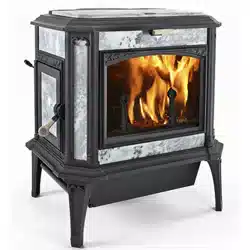Loading ...
Loading ...
Loading ...

Avoid overfiring by letting the combustor and secondaries do most of the work in the stove. Your stove
is operating at peak efficiency when the combustor is “engaged”and the secondaries are ignited, with the
damper lever set to a low to moderate setting, and the logs are glowing with secondary flames apparent.
You will get the greatest amount of heat per pound of wood when the stove is operated in this manner.
Daily Use
Your Progress stove is well-suited for continuous firing on a 24 hour-a-day basis. It will burn for hours
on one load of wood, and will provide steady, even heat for hours after the fire dies down. One of the
qualities of soapstone most enjoyed by wood burners is its ability to absorb heat and then to release the
heat evenly. When the temperature on top of the stove drops below 250ºF during an all-night burn, it is
not necessary to disengage the combustor. You need only disengage the catalytic combustor when you
kindle a fire, or reload the stove. Once the catalyst is ignited, it will continue to function as long as there
is smoke to burn. This is true even if the surface temperature on top of the stove drops below 250ºF at
the end of a long burn.
Your connector pipe and chimney or chimney pipe should be inspected at regular intervals (not less
than once every two months). Examine the connector pipe for creosote, corrosion, loose seams, or exces-
sive soot. Clean and replace as necessary. The chimney or chimney pipe should be cleaned and checked
by a certified specialist once a year. A small mirror held at the cleanout door of a masonry chimney will
be helpful. For a class A prefabricated metal pipe, some disassembly is usually required.
The Fall-Away Handle
The “fall-away” handle, which comes with your stove, can be used to operate
the side door latch or the catalytic bypass damper. Simply insert the round
knob end of the Fall-Away Handle into the door pull ring to open/close, or
latch/unlatch the loading door. The loading door and the pull ring and the
catalytic bypass handle are very hot, so use the tool provided. The “fall-away”
handle conforms to UL requirements and is made so that if you let go of it, it
will “fall-away” from the stove and not become too hot to handle.
The Progress Cook Top
The top lid of the Progress wood stove consists of a three-piece stone set and
a cast iron plate below. The lid has been designed to enhance the beauty and versatility of your stove.
The soapstone serves to provide long lasting radiant heat as well as the perfect cooking surface for foods
to simmer over moderate heat for longer periods. The stone panels can be raised individually or
collectively to expose the cast iron cook top underneath. The cook top has three distinct areas that
provide high, medium, and low temperature zones for more cooking flexibility. The center “burner” is
flush and delivers the highest heat. The left is elevated about 1/16” and provides medium heat. The right
is raised 1/8” and has the lowest temperature. In general, if the temperature on the stone is 300°-350° the
center of the cast iron cook top is 500°-550°. The temperature drops approximately 50° per 1/16” of
height, so the left burner would be 50° cooler than the center and the right burner 100° cooler. The cast
iron cook top is not designed as a cooking surface and food should always be placed in a heavy duty
Dutch oven or skillet, not directly onto the cast iron.
The stones can be removed completely from the stove, and the cast iron cook top will stand upright in
the rear channel to access the catalytic combustor below. This easy access makes cleaning and replacing
the combustor very user friendly.
19
The fall-away handle may be
used to operate the controls on
your stove when they are too
hot to handle safely.
Loading ...
Loading ...
Loading ...
